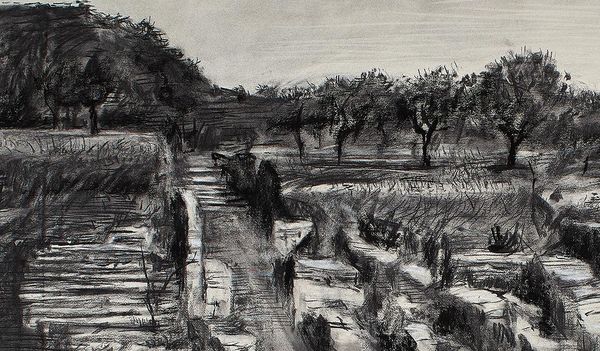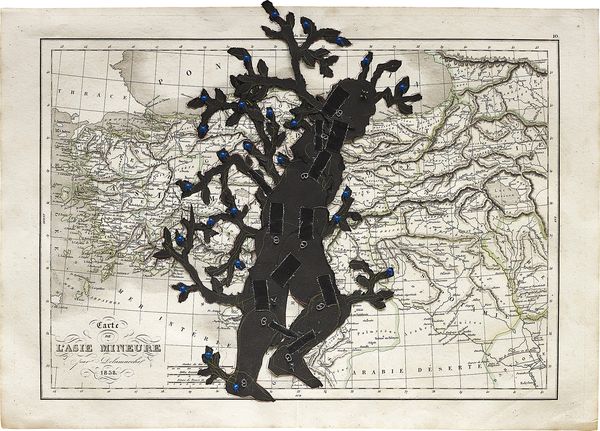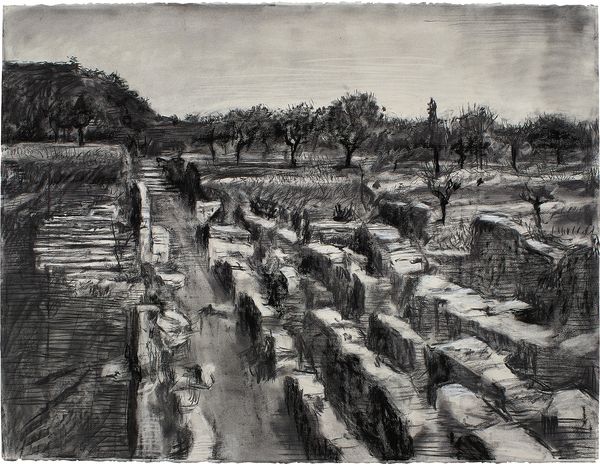William Kentridge Drawing from the animation for Il Ritorno d'Ulisse, 1998 (detail)
Covering a wide breadth of genres—animation, drawing, collage and performance, among others—William Kentridge's creations come close to what German opera-composer Richard Wagner named 'Gesamtkunstwerk': the synthesis of various or all art forms. Fascinated with theatre, history, politics and materiality, Kentridge conjures these themes in complex polymorphic works, producing pieces at once experimental and minutious, structurally fragmented and conceptually exhaustive. The artist's South African background furthermore pervades his work, lending it always a tone at once intimate and political.
Phillips is pleased to present three of the Kentridge's elaborate paperworks from the late 1990s and early 2000s in our London Day Sale on 4 October. Each representative of the artist's idiosyncrasies developed over the course of a five-decade-long career, Puppet Drawing (2000), Drawing from the animation for Il Ritorno d'Ulisse (1998) and MC2 – Drawing from "Medicine Chest" (2000-12) most strikingly showcase the artist's interest in revealing processes of creation.
As they lay bare erasures, smudges and altered forms, these three works on paper highlight the importance of movement and methodic development in Kentridge's oeuvre. They are rendered alive through the exposure of their multiple recesses, balancing to and fro to become what they are, and, in this perspective, collectively encapsulate the artist's desire to observe the 'drawing drawing itself', like a filmic sequence or an image in motion.
This passion for action and incremental progression, Kentridge drew from his long-standing love of theatre. Growing up, the artist wished to become an actor, and though he never fully carried out this aspiration, Kentridge kept theatrical ambitions at the core of his artistic expression. Each of the artist's works is thus profoundly narrative-driven and utilizes theatrical or expressionist language to convey motion and emotion. Constantly rethinking the boundaries of drawing and two-dimensionality, Kentridge indeed propulses his creations beyond the confines of their medium, thereby challenging the static nature they inherently suggest.
The artist's poetically haunting works...contain within their dark folds and creases the voices of torn societies.
William Kentridge Puppet Drawing, 2000
Puppet Drawing is emblematic of Kentridge's experimental approach to representation on a formal level. A collage assembling tape, chalk and pins on a topographic map, this small construction juxtaposes materials and concepts alike, equating the immensity of a region with the humble size of a man, a specific spatiotemporal context with an atemporal, fictional silhouette, simple paper support with crafted paper constructions...
On this multilayered composition, a 'tree-man' (one of Kentridge's signature motifs) strides along the drawn-out surface of 1838 Anatolia, evoking issues relating to identity and shifting geographic dispositions. With this particular map, Kentridge points to the significant migration rates reported following the integration of Eastern Armenia into the Russian Empire in 1828. The half-man, half-tree figure, freely transforming and moving across the paper support, thus symbolizes the motions of a community and the ramifications entailed by the conflation of cultural subjectivities.
Drawing from his own background, Kentridge has often addressed such socio-political matters. His country's stricken state, following the terror and injustice of Apartheid, particularly motivated the expression of these matters; the artist's poetically haunting works, as such, contain within their dark folds and creases the voices of torn societies.
William Kentridge MC2 – Drawing from "Medicine Chest", 2000-12
MC2 – Drawing from "Medicine Chest" draws from a larger project. Divided in three roughly equal parts, the charcoal drawing presents the viewer with a threefold perspective of a barren landscape, with the interesting presence of a screen-like structure on the paper’s top-tier. This drawing formed part of an installation of sorts, whereby Kentridge projected hand-made animations inside a cabinet mirror — a 'medicine chest' — displaying images as varied as a gyroscope, the barren landscapes at hand, and the artist himself.
William Kentridge Drawing from the animation for Il Ritorno d'Ulisse, 1998
Drawing from the animation for Il Ritorno d'Ulisse reimagines a tale as old as time. In 1998 and interspersedly until 2016, Kentridge designed and directed his version of the eponymous Monteverdi opera. With the help of human-size puppets and trademark animations, Kentridge gave life to text and drawings. Executed with charcoal on paper and stretching over 160cm tall, Drawing from the animation for Il Ritorno d'Ulisse is a unique element extracted from one of these theatrical performances.
In recreating iconic historical operas, using dramatic contrast in drawings, and projecting images on blank space as he would characters on a stage, the South African artist ceaselessly works with and upon theatrical notions. The three works presented in our Day Sale readily demonstrate this, exuding a sense of performativity in form, content or context.



